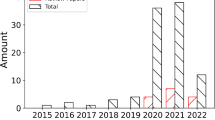Abstract
Aflatoxin contamination in peanut crops is a problem of significant health and financial importance. Predicting aflatoxin levels prior to crop harvest is useful for minimizing the impact of a contaminated crop and is the goal of our research. Backpropagation neural networks have been used to model problems of this type, however development of networks poses the complex problem of setting values for architectural features and backpropagation parameters. Genetic algorithms have been used in other studies to determine parameters for backpropagation neural networks. This paper describes the development of a genetic algorithm/backpropagation neural network hybrid (GA/BPN) in which a genetic algorithm is used to find architectures and backpropagation parameter values simultaneously for a backpropagation neural network that predicts aflatoxin contamination levels in peanuts based on environmental data. Learning rate, momentum, and number of hidden nodes are the parameters that are set by the genetic algorithm. A three-layer feed-forward network with logistic activation functions is used. Inputs to the network are soil temperature, drought duration, crop age, and accumulated heat units. The project showed that the GA/BPN approach automatically finds highly fit parameter sets for backpropagation neural networks for the aflatoxin problem.
Similar content being viewed by others
References
U.S. Food and Drug Administration Center for Food Safety and Applied Nutrition, Foodborne Pathogenic Microorganisms and Natural Toxins, U.S. Food and Drug Administration: Washington, DC, 1992.
C.N. Thai, P.D. Blankenship, R.J. Cole, T.H. Sanders, and J.W. Dorner, "Relationship between aflatoxin production and soil temperature for peanuts under drought stress," Transactions of the ASAE, vol. 33, no. 1, pp. 324–329, 1990.
R.J. Cole, T.H. Sanders, R.A. Hill, and P.D. Blankenship, "Mean geocarposphere temperatures that induce preharvest aflatoxin contamination of peanuts under drought stress," Mycopathologia, vol. 91, no. 1, pp. 41–46, 1985.
C.E. Henderson, "Using genetic algorithms to evolve neural networks," Master's Thesis, Artificial Intelligence Center, The University of Georgia, 1997.
D.E. Goldberg, Genetic Algorithms in Search, Optimization and Machine Learning, Addison Wesley: Reading, MA, 1989.
K. Balakrishnan and V. Honavar, "Properties of genetic representations of neural architectures," in Proceedings of the World Congress on Neural Networks, 1995, pp. 807–813.
G.F. Miller, P.M. Todd, and S.U. Hegde, "Designing neural networks using genetic algorithms," in Proceedings of the Third International Conference on Genetic Algorithms, 1989, pp. 379–384.
M. Mitchell, An Introduction to Genetic Algorithms, The MIT Press: Cambridge, MA, 1996.
L. Marti, "Genetically generated neural networks II: Searching for an optimal representation," in Proceedings of the 1992 IEEE International Conference on Neural Networks, 1992, pp. 221–226.
H. Kitano, "Designing neural networks using genetic algorithms with graph generation system," Complex Systems, vol. 4, pp. 461–476, 1990.
F. Gruau, D. Whitley, and L. Pyeatt, "Acomparison between cellular encoding and direct encoding for genetic neural networks," in Genetic Programming 1996: Proceedings of the First Annual Conference, 1996, pp. 81–89.
D. Dasgupta, "Evolving neuro controllers for a dynamic system using structured genetic algorithms," in Proceedings of the TenthInternational Conference on Industrial and Engineering Applicationsof Expert Systems and Artificial Intelligence, Gordon and Breach Science Publishers, 1990.
S.G. Roberts and M. Turega, "Evolving neural network structures: An evaluation of encoding techniques," in Artificial Neural Nets and Genetic Algorithms: Proceedings of the International Conference in Ales, France, 1995, pp. 96–99.
S.A. Harp, T. Samad, and A. Guhu, "Towards the genetic synthesis of neural networks," in Proceedings of the Third International Conference on Genetic Algorithms, 1989, pp. 360–369.
D. Schaffer, R.A. Caruana, and L.J. Eshelman, "Using genetic search to exploit the emergent behavior of neural networks," Emergent Computation, S. Forrest, ed. MIT press, pp. 244–248, 1990.
R.K. Belew, J. McInerney, and N.N. Schraudolph, "Evolving networks: Using genetic algorithms with connectionist learning," CSE Technical Report CS90–174, La Jolla, CA, University of California at San Diego, 1990.
D.J. Chalmers, "The evolution of learning: An experiment in genetic connectionism," in Proceedings of the 1990 Connectionist Models Summer School, Morgan Kaufmann: San Mateo, CA, 1990, pp. 81–90.
R.S. Parmar, R.W. McClendon, G. Hoogenboom, P.D. Blankenship, R.J. Cole, and J.W. Dorner, "Estimation of aflatoxin contamination in preharvest peanuts using neural networks," Transactions of the ASAE, vol. 40, no. 3, pp. 809–813, 1997.
C.S. Pinto, "Prediction of aflatoxin contamination in peanuts using artificial neural networks," Master's Thesis, The University of Georgia, 1996.
D.E. Rumelhart, G.E. Hinton, and J.L. McClelland, "A general framework for parallel distributed processing," Parallel Distributed Processing: Explorations in the Microstructure of Cognition, Vol. 1: Foundations, MIT Press: Cambridge, Mass., 1987.
Author information
Authors and Affiliations
Rights and permissions
About this article
Cite this article
Henderson, C., Potter, W., McClendon, R. et al. Predicting Aflatoxin Contamination in Peanuts: A Genetic Algorithm/Neural Network Approach. Applied Intelligence 12, 183–192 (2000). https://doi.org/10.1023/A:1008310906900
Issue Date:
DOI: https://doi.org/10.1023/A:1008310906900




